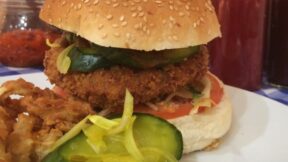Blogs
What do Tapas have in common with men?

Some of the best seafood in the world
Our annual foodie weekend was so good last year that we decided to return to the same place again, Santiago de Compostella in Northern Spain. We love Galician food, it really does have some of the best seafood in the world and you can visit the incredible cathedral.
As we pondered over yet another bottle of fine Spanish wine (favourites are from the region of Ribera del Duero and in particular the Cristobel Lopez) we decided that Tapas are like men; there is a wide variety, they come in all shapes and sizes, there’s one to suit everyone and you don’t have to commit to just one course, you can try a few!
Origins of Tapas
There are rumoured to be 138,000 bars in Spain, this is as many as the rest of Western Europe put together. Tapas literally means ‘topping’ and was originally invented to keep the flies out of drinks. The word ‘tapas’ is derived from the Spanish verb tapas, ‘to cover’.
According to ‘The Joy of Cooking’, the original tapas were the slices of bread or meat which sherry drinkers in Andalusia taverns used to cover their glasses between sips. This was a practical measure meant to prevent fruit flies from hovering over the sweet sherry. The meat used to cover the sherry was normally ham or chorizo, which are both very salty and activate thirst. Because of this, bartenders and restaurant owners began creating a variety of snacks to serve with sherry, thus increasing their alcohol sales. The tapas eventually became as important as the sherry and the rest is history.
Social
There’s something about a Tapas bar that is extremely convivial. A few more glasses and we decided It is because of the shared experience. After we each tasted the tapas we discussed them in great detail, deciding whether to order more, move on to the next tapas bar or just choose another one from the menu.
Tapas bars are part of the Spanish psyche of being together and tapas as a social eating experience provides this. Tapas are served in a wide range of bars; we ate in everything from the most basic, described by David James as, “Like eating in a men’s urinal!” through to top-end award wining tapas bar, worthy of a Michelin star.
Provenance
The Tapas on offer typically reflect the region’s culinary traditions, agricultural and fishing. The North Western coast of Spain has a long fishing tradition and we visited the local Fish market at Mercado de Abastos to get a closer look at what was on offer. The abundance of fish staggering, from tiny chanquetes (White Bait), through to centurion crabs, octopus and very expensive and hard to come-by, percebes (gooseneck barnacles). Every palate was catered for and we could tell how fresh it was because there was no fishy smell just a salty taste.
Galicians or Gallegos as they are called in Spanish are not rich people and because of the rugged landscape and rough weather, they use every bit of what they grow or catch, including using shells as fertiliser for the soil. In the market we saw stands selling every type of meat you could imagine and absolutely nothing was wasted, even the piggy’s ears were for sale. Each stall had something special to offer and we left with great memories of fresh seafood- reputedly some of the best in the world.
If you are planning a trip to Santiago then make sure you let us know, we have some great Tapas bars we can recommend.
Written by Wendy Bartlett, Managing Director; David James, Food Service Director and Lin Dickens, Marketing Director.




